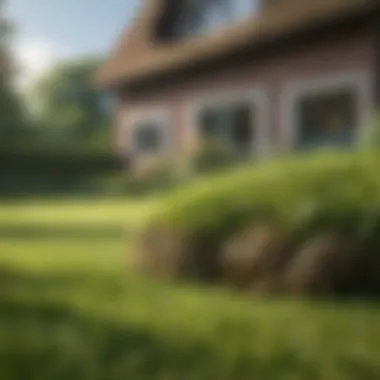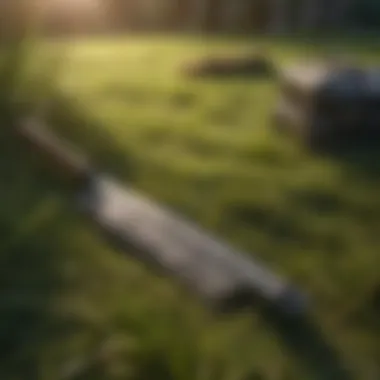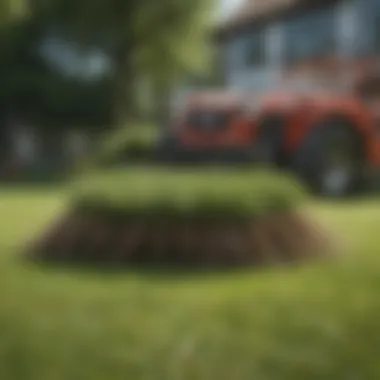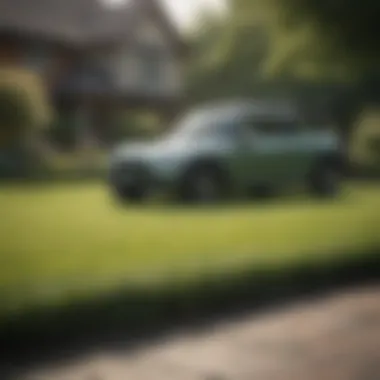Understanding Dethatching: Timing and Techniques


Intro
Dethatching is a vital process in maintaining a healthy and lush lawn. As homeowners and gardening enthusiasts strive for a vibrant outdoor space, understanding the concept of thatch becomes increasingly important. Thatch refers to the layer of organic matter that accumulates on the soil's surface. While some thatch can benefit the lawn, excessive buildup can lead to various problems.
Recognizing the signs of excess thatch and knowing when to dethatch can significantly impact the health of your turf. This guide will explore the timing and techniques involved in dethatching, providing readers with the tools they need to achieve a thriving lawn.
The section ahead will delve into when to dethatch, the symptoms of thatch buildup, and the most effective methods for this critical lawn care step. By understanding the timing and technique of dethatching, you can enhance the overall appearance and resilience of your grass.
Understanding Thatch
Thatch forms from the accumulation of grass clippings, roots, and other organic debris. A small amount of thatch can be beneficial as it retains moisture and nutrients. However, when thatch exceeds half an inch, it can prevent water, air, and nutrients from reaching the grass roots, leading to poor lawn health.
Symptoms of Excess Thatch
Homeowners should watch for the following signs of excessive thatch:
- Poor drainage: Water pooling on the surface after rainfall can indicate thatch is preventing proper absorption.
- Irregular growth patterns: Grass may appear to grow unevenly or be prone to wilting.
- Increased pest activity: A thick thatch layer can create a habitat for pests and diseases, affecting the lawn's overall health.
Optimal Timing for Dethatching
Timing plays a crucial role in successful dethatching. The best time to perform this task generally depends on the type of grass in your lawn.
Cool-Season Grasses
For cool-season grasses like Kentucky bluegrass, the ideal time to dethatch is during the early spring or early fall. These periods allow grass to recover quickly after the process.
Warm-Season Grasses
In contrast, warm-season grasses such as Bermuda grass should be dethatched in late spring or early summer when the grass is actively growing. Dethatching during this period minimizes damage and promotes healing.
Tools and Techniques for Dethatching
Selecting the right tools is essential for effective dethatching. Homeowners may choose between:
- Dethatching Rakes: Manual dethatching rakes can be useful for small areas, allowing precise control.
- Power Dethatchers: For larger lawns, powered dethatchers are more efficient. They remove more thatch in less time.
Dethatching Process
- Mow your lawn to a short height to allow your tools to reach the thatch layer easily.
- Choose the appropriate tool based on the area size and the amount of thatch.
- Work methodically, covering the area with overlapping strokes to ensure comprehensive coverage.
- Collect and dispose of the removed thatch to prevent it from decomposing back into the lawn.
Post-Dethatching Care
After dethatching, it is crucial to give your lawn appropriate care. Here are some recommendations:
- Aerate: Consider aerating your lawn to further improve soil compaction and promote root growth.
- Water: Keep the lawn well-watered but avoid overwatering.
- Fertilize: Applying a mild fertilizer can help stimulate new growth.
"Proper dethatching and care can significantly improve the health of your lawn, leading to greener grass and a more enjoyable outdoor space."
Common Mistakes to Avoid
Dethatching can be detrimental if done improperly. Avoid the following common mistakes:
- Dethatching unhealthy lawns: Ensure that your grass is healthy before proceeding.
- Ignoring the weather: Choose dry conditions to dethatch, as wet soil can cause more harm.
- Overdoing it: Excessive dethatching can damage grass roots, leading to further lawn issues.
By adhering to the guidelines in this article, you can execute this essential lawn care task effectively and contribute positively to the health of your lawn.
Foreword to Dethatching
Dethatching is a vital practice in lawn care, often overlooked by many homeowners. Understanding this process is essential for anyone seeking a greener and healthier lawn. By managing thatch buildup effectively, one can enhance lawn vitality and prevent issues such as pests and disease. This guide will delve deeper into dethatching and its nuances.


What is Dethatching?
Dethatching refers to the removal of thatch, a layer of organic debris that accumulates between the grass and the soil. This layer consists of dead grass, root fragments, and other organic matter. While a small amount of thatch can be beneficial—it helps retain moisture and provides some insulation—excessive buildup can restrict water, nutrients, and air from reaching the soil.
In a practical sense, dethatching is typically achieved through various methods such as manual rakes or mechanical dethatchers. Regular dethatching can lead to a more robust, resilient lawn, contributing to its overall aesthetic.
The Importance of Dethatching
Understanding the significance of dethatching is key to maintaining a vibrant lawn.
- Soil Health: Removing thatch can prevent compaction and promote better root growth. Thatch can trap excess moisture and create a breeding ground for diseases, adversely affecting the grass's health.
- Water and Nutrient Access: By dethatching, you enhance the soil's ability to absorb water and nutrients. This can lead to a healthier plant, less reliant on fertilizers and excessive watering.
- Aesthetic Appeal: A lawn that is regularly dethatched tends to look lush and vibrant. This not only boosts your property’s curb appeal but also provides a pleasant environment for outdoor activities.
In summary, dethatching is not merely a cosmetic procedure; it is an essential aspect of lawn maintenance that benefits both the grass and the overall landscape.
Identifying When to Dethatch
Dethatching is a vital part of lawn care. Knowing when to dethatch can make a significant difference in the health of your turf. By identifying the right time to perform this task, homeowners can ensure that their lawns receive the necessary care and attention. Improper timing can lead to stress on grass and hinder its ability to recover.
Signs of Excess Thatch
Recognizing the signs of excess thatch is the first step in understanding when to dethatch. Thatch is a layer of dead grass, roots, and other organic material that accumulates on the soil surface. While a small amount of thatch can be beneficial, too much can create problems.
There are several indicators of excessive thatch:
- Lawns feel spongy underfoot: If walking on your lawn gives a sponge-like sensation, that is a clear sign of too much thatch buildup.
- Poor water absorption: If water seems to pool on the surface instead of soaking into the ground, excess thatch may be blocking absorption.
- Dying grass: Patches of brown grass may appear, indicating that the roots are not getting enough moisture or nutrients due to thatch.
- Presence of insects or disease: Excessive thatch can create a breeding ground for pests and diseases, which can further damage your lawn.
Paying attention to these signs can help determine the need for dethatching.
Seasonal Indicators
Seasonality plays an important role in lawn care, especially in dethatching. Different seasons bring distinct growth patterns and environmental conditions.
- Early Spring: For cool-season grasses, early spring is an ideal time for dethatching as the lawn begins to actively grow. This helps the roots establish better.
- Late Summer to Early Fall: For warm-season grasses, dethatching during the late summer or early fall supports recovery before winter dormancy.
- Timing with Weather: Avoid dethatching immediately after heavy rainfall or under drought conditions. The soil should be moist but not saturated.
Understanding these seasonal trends will assist gardeners in making informed decisions about the best time to dethatch.
Timing Your Dethatching
Timing plays a crucial role in the dethatching process. Proper timing can make the difference between a thriving lawn and one that suffers due to excessive thatch. Each season offers distinct advantages for dethatching, yet these will vary depending on the type of grass present in the lawn. A well-timed dethatching session not only improves water and nutrient penetration but also allows grass to recover and grow more vigorously.
Best Seasons for Dethatching
Spring
Spring is often considered a favorable time for dethatching, especially for cool-season grasses such as Kentucky bluegrass and fescue. As temperatures begin to rise, grass enters a crucial growth stage. Dethatching during this period can stimulate new growth and allow the lawn to recover quickly.
However, homeowners should be aware that dethatching too early in spring carries risks. If still too cold, grassroots may not be well-established, resulting in potential damage. It is vital to wait until the danger of frost has passed and the grass has started actively growing. The unique feature of spring dethatching is its potential for revitalizing the lawn just as it begins to emerge from dormancy. By removing the thatch, the lawn can breathe and receive nutrients effectively.
Fall
Fall is another prime time for dethatching. The cooler temperatures combined with ample moisture create ideal conditions for grass recovery. For warm-season grasses like Bermuda or zoysia, fall dethatching allows the lawn to reduce thatch before the grass goes dormant for winter. This timing helps prepare the lawn for a robust emergence in spring.
Key benefits of fall dethatching include reduced competition for nutrients and moisture, as most weeds are also in decline during this season. If executed correctly, this can lead to a healthier lawn come spring. However, if the temperature drops too soon, dethatching may weaken the grass, leaving it vulnerable to winter damage.
Regional Considerations
Timing for dethatching also heavily depends on regional climates and grass types. For example, homeowners in the northern regions should typically dethatch in early spring, while those in southern areas might find fall to be the best option for warm-season grasses. Understanding local climate patterns can enhance dethatching results significantly.
In summary, both spring and fall present valuable opportunities for dethatching. Each season possesses unique features and potential pitfalls. Assessing these factors can aid in making informed decisions, ensuring a more lush and healthy lawn.


Types of Grass and Their Dethatching Needs
Dethatching is not a one-size-fits-all process. The type of grass you have in your lawn greatly influences how you perform dethatching. Different grasses have unique growth patterns and responses to thatch, making it essential to understand the specific requirements based on grass type. The main categories are cool-season and warm-season grasses, each presenting distinct characteristics that inform dethatching practices. Knowing these differences can lead to healthier, more resilient lawns.
Cool-season Grasses
Cool-season grasses thrive in the temperate regions, growing best when temperatures range between 60°F to 75°F. Common types include Kentucky bluegrass, tall fescue, and perennial ryegrass. These grasses generally go through a period of dormancy during the hot summer months, making spring and fall the best seasons for dethatching.
When dethatching cool-season grasses, it is critical to assess thatch accumulation. Typically, these types do not accumulate thatch as quickly as warm-season varieties, though excessive buildup can still occur, especially in poorly drained or over-watered lawns. Signs such as yellowing grass or water pooling can indicate the presence of thatch. To optimize the dethatching process, it is advisable to
- Mow the grass slightly shorter before starting. This reduces the amount of material left behind.
- Aerate the soil after dethatching. It improves soil conditions and encourages better absorption of water and nutrients.
Warm-season Grasses
Warm-season grasses, such as Bermudagrass, zoysiagrass, and St. Augustinegrass, prefer higher temperatures, typically thriving between 75°F and 90°F. These grasses grow vigorously during the warmer months and rest during the cool seasons, meaning dethatching should primarily take place in late spring or early summer when they are actively growing.
Due to their aggressive growth habit, warm-season grasses can develop higher amounts of thatch, particularly in lawns that receive heavy foot traffic or improper maintenance. Signs of thatch issues include poor drainage or difficulties in water absorption. To address these problems, it’s important to
- Use a dethatching rake or a specialized dethatcher machine to remove thick layers of thatch effectively.
- Consider overseeding after dethatching, as this can help rejuvenate the lawn and establish a thicker turf, preventing thatch buildup in the future.
Understanding the types of grass present in your lawn aids in tailoring dethatching methods for best results. Maintaining optimal health for your specific grass variety will lead to a more vibrant lawn overall.
Tools for Dethatching
Selecting the right tools for dethatching is critical for achieving optimal results in lawn care. The tools you use can affect the efficiency, effectiveness, and overall health of your lawn post-dethatching. Understanding the available options is key to making informed decisions that suit your specific lawn conditions.
Manual Dethatching Tools
Manual dethatching tools are often the first choice for smaller yards or for those who prefer a hands-on approach. These tools typically include rakes and specialized dethatching implements.
- Thatch Rake: This tool has sharp, curved blades designed to cut through thatch. It is effective for manual removal of thatch layers, especially in localized areas.
- Lawn Scarifier (Manual): Also known as a lawn dethatcher, this tool works similarly to a thatch rake but might provide better penetration with less effort due to its unique blade design.
Using manual tools allows for greater control but requires more physical effort and time investment. Thus, it may be less practical for larger lawns.
Mechanical Dethatching Equipment
Mechanical dethatching equipment is designed for larger areas and can greatly reduce the time and effort required for this task. These are typically powered tools that can effectively handle thick layers of thatch without the intensive labor that manual tools require.
- Dethatching Machine: This is a motorized piece of equipment that mechanically removes thatch. It uses a series of rotating blades to pull up thatch while causing minimal disturbance to the soil.
- Power Rake: Often heavier-duty than standard dethatchers, power rakes provide a more aggressive approach to dethatching. They can penetrate deeper into thatch layers and are suited for more extensive renovations.
Utilizing these mechanical tools can lead to a more consistent dethatching process and less physical strain on the user. However, they typically require some level of expertise to operate effectively. It is advised to read the instructions carefully or consider renting from a local equipment supplier for the best outcome.
In summary, the choice between manual and mechanical dethatching tools largely hinges on the size of your lawn and your personal preferences regarding effort and control. Ensuring you have the right tool will contribute significantly to the success of your dethatching project.
"Choosing the right dethatching tool ensures both efficiency and the health of your lawn post-process."
By understanding the functionalities and applications of each available tool, you can make an informed choice that benefits your lawn care regimen.
The Dethatching Process
Dethatching is a vital step in maintaining a healthy lawn. This process involves the removal of thatch, a layer of organic matter that builds up between the grass blades and the soil. If left unchecked, thatch can restrict water, air, and nutrients from reaching the roots of your grass. Here, we will explore the preparation and execution stages of dethatching to ensure that your lawn remains robust and vibrant.
Preparing Your Lawn
Preparation is crucial for successful dethatching. Without proper preparation, you may compromise the health of your lawn. Before starting, it is essential to mow your grass to a lower height, typically about one to two inches. This helps to facilitate easier access to thatch. Additionally, consider watering your lawn a day or two before dethatching. A slightly moist soil is easier to work with and can increase the effectiveness of the process.
Next, remove any debris, such as sticks and stones, from your lawn. This ensures that your dethatching tools can work efficiently without interruption. If your lawn has a significant amount of thatch, take a moment to observe the soil condition. Heavy clay soils will require more care than sandy ones. Be sure to also check the weather forecast—ideally, choose a day that is not too windy or wet, as these conditions can affect how effectively you can dethatch.
Executing the Dethatching


Executing the dethatching process can be done either manually or mechanically, depending on the size of your lawn. For small areas, a manual dethatching rake can be effective. Simply rake the thatch away, working in multiple directions to break up the buildup thoroughly. Manual methods might take time and effort, but they offer a good workout and ensure close attention to detail.
For larger lawns, mechanical dethatchers are highly recommended. These machines operate by using vertical blades to slice through the thatch layer, pulling it up to the surface for easy removal. When using a mechanical dethatcher, make sure to follow the manufacturer's instructions for optimal results. It is often advisable to make a few passes over the same area, adjusting the machine settings to reach different depths of thatch.
Once the dethatching is completed, collect the debris generated from the process. Leaving it on the lawn can lead to new thatch forming, negating your efforts. You can compost the removed thatch or dispose of it properly.
Important Note: Always keep your dethatching tools clean and in good condition. This increases their effectiveness and longevity.
Post-Dethatching Care
Post-dethatching care is a crucial phase in the lawn maintenance process that often gets overlooked by homeowners. Once the thatch has been removed, ensuring that the lawn flourishes should become a top priority. This stage involves two significant activities: lawn reseeding and fertilization. Proper care will help revive the lawn, encouraging healthy growth and restoring its vitality.
Lawn Reseeding
Lawn reseeding is essential after dethatching, particularly if the process has led to bare patches. Reseeding allows the grass to establish new roots, filling in any gaps left behind. This is especially relevant for cool-season and warm-season grasses, which will respond differently depending on the season.
Considerations for Reseeding:
- Timing: Choose the right season for reseeding. For cool-season grasses, early spring and fall are optimal. In contrast, warm-season grasses thrive when seeded in late spring or early summer.
- Seed Selection: Select a seed variety that matches your existing lawn. This ensures uniform growth and aesthetic appeal.
- Preparation: Before reseeding, lightly rake the prepared soil to enhance seed-to-soil contact. This step increases the chances of successful germination.
- Watering: Keep the soil moist to facilitate seed germination. Avoid overwatering, as this can lead to other issues.
Fertilizing After Dethatching
Fertilizing after dethatching provides necessary nutrients for grass recovery. Dethatching can deplete nutrients, so applying fertilizer replenishes this essential component. Choosing the right fertilizer is integral to achieving optimal results.
Benefits of Fertilization:
- Nutrient Boost: Fertilizers supply nitrogen, phosphorus, and potassium, fostering healthy grass development.
- Enhanced Recovery: Fertilization promotes quick recovery from stress caused by dethatching, allowing grass to bounce back.
- Soil Health: Quality fertilizers improve soil structure and fertility, supporting microbial activity that benefits grass.
Tips for Fertilizing:
- Choose the Right Type: Organic fertilizers are often recommended for a gentler approach. Synthetic options can work as well, but timing matters.
- Application: Distribute fertilizer evenly and according to package instructions. Standard practices would include applying before rain if possible, as this helps in nutrient absorption.
A well-maintained lawn post-dethatching not only looks better but is also more resilient against pests and disease.
Common Mistakes in Dethatching
Dethatching is an essential lawn care practice, but many homeowners make errors that can undermine the benefits of this process. Understanding these common mistakes is crucial for achieving a healthy lawn. This section identifies the critical errors made during dethatching and provides insights on how to avoid them. Recognizing these missteps will enhance the effectiveness of your efforts, ultimately contributing to a lush, vibrant lawn.
Ignoring Soil Condition
One significant mistake is ignoring the condition of the soil before dethatching. Soil health is a fundamental aspect of effective lawn care. If the soil is compacted or lacks nutrients, dethatching may not yield the desired results. It is important to examine the soil first. Check for compaction by pushing a screwdriver or similar tool into the ground. If it resists easily, your soil may need aeration.
When dethatching on unhealthy soil, you risk further damaging your lawn. Compacted soil hinders root growth and limits water absorption. This can lead to more thatch buildup in the future. Before starting the dethatching process, consider testing your soil. A soil test can reveal nutrient levels and help determine if amendments are necessary.
Dethatching Too Early or Late
Another common mistake is timing the dethatching process incorrectly. Dethatching too early in the spring or too late in the fall can stress the grass. Each type of grass has its own growing season. For cool-season grasses, the best time to dethatch is early spring or early fall, while warm-season grasses should be dethatched in late spring or early summer. If you dethatch too early, the grass may not yet be ready to recover, leading to potential damage. If done too late, the grass may not have sufficient time to heal before winter.
It’s essential to pay attention to local weather patterns and grass type. Observing growth stages can help in making the right decision on when to dethatch. Following these guidelines will help ensure that your efforts contribute positively to the lawn's overall health.
Important: Always assess both soil condition and timing to avoid common pitfalls in dethatching.
Ending
Understanding dethatching is crucial for maintaining a healthy lawn. This process helps manage thatch buildup, which, if left unchecked, can hinder grass growth and overall lawn health. In this article, we explored various aspects of dethatching, including when it should be done and the tools required for effective execution.
One key takeaway is the importance of recognizing signs of excess thatch. By monitoring your lawn for brown patches or water pooling, homeowners can identify when dethatching is necessary. Timing also plays a significant role; knowing the best seasons for your specific type of grass can enhance the effectiveness of dethatching efforts.
Moreover, post-dethatching care such as reseeding and fertilization cannot be overlooked. These steps contribute to restoring the lawn's vitality after dethatching, ensuring that the grass can thrive in a healthier environment. Consequently, this article provides essential knowledge that empowers readers to make informed decisions about lawn care.
Summary of Key Points
- Dethatching is vital for removing harmful thatch buildup in the lawn.
- Signs of excess thatch include poor drainage, weak grass growth, and dead patches.
- Best times to dethatch vary depending on grass type and climate.
- Essential tools include both manual and mechanical dethatching equipment.
- Post-dethatching care greatly affects the recovery and health of the lawn.
Final Thoughts on Dethatching
Consideration of timing, technique, and lawn care post-dethatching helps in achieving the best results. Whether you are a novice or seasoned gardener, understanding the dethatching process allows better management of your outdoor space. This knowledge benefits not only the lawn itself but also enhances the enjoyment and satisfaction of maintaining a vibrant and flourishing environment outside your home.







